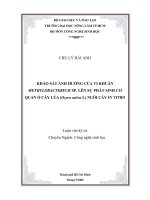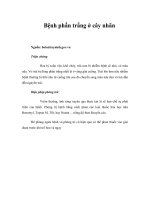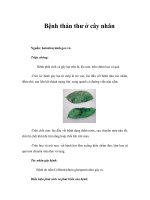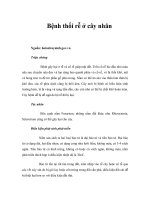Hyperthyroidism BỆNH CƯỜNG GIÁP Ở CÂY LÚA
Bạn đang xem bản rút gọn của tài liệu. Xem và tải ngay bản đầy đủ của tài liệu tại đây (1.49 MB, 58 trang )
Hyperthyroidism
« GROUP 1 »
OVERVIEW
1.
2.
3.
4.
5.
Thyroid Gland Anatomy – Physiology.
Pathology
Definition
Epidemiology
Pathogen
OVERVIEW
6. Management:
6.1 Clinic
6.2 Subclinic
6.3 Treatment
6.4 Complication & Sequela
7. Clinical case
1. Thyroid Gland Anatomy – Physiology
1. Thyroid Gland Anatomy – Physiology
1. Thyroid Gland Anatomy – Physiology
Control of thyroid function
The synthesis and release of
thyroid hormones is
regulated by negative
feedback
mechanism involve:
-The pituitary hormone TSH
(thyroid stimulating hormone)
-The TRH
(thyrotropin releasing
hormone)
1. Thyroid Gland Anatomy – Physiology
The normal thyroid gland
produces about 80% T4 and
about 20% T3, however, T3
possesses about four times the
hormone "strength" as T4.
T4 is involved in controlling
the rate of metabolic
processes in the body and
influencing physical
development.
1. Thyroid Gland Anatomy – Physiology
· Increased expression of Na/K ATPase;
Tissue effects of T3 include:
· increased sarcolemmal calcium uptake
· increased beta adrenergic receptor levels in myocardium;
· increased hepatic production of sex steroid binding globulin;
· Bone: (cartilage ossification, maturation of epiphyses, chondrocyte maturation; - thyroid hormone has a
direct effect on bone, and indirect effects through growth hormone release and IGF-1 action);
· neuronal: cortical growth, axonal and dendritic growth, myelination; T3 is vital for normal brain
development, and fetal TSH secretion starts by about 11-12 weeks. The auditory and visual sensory
systems appear particularly dependent on T3
· renal: increased renal plasma flow and GFR, Tm in tubules
2. Pathology
Hyperthyroidism’s Causes
Grave Disease (Basedow )
2. Pathology
2. Pathology
Toxic Multinodular Goiter
3. Definition
Hyperthyroidism is the overproduction of thyroid hormones by an overactive
thyroid.
3. Epidemiology
4
:
1
Age: 20 - 40
4. Pathogen
•
•
•
•
•
Basedow
Toxic Adenoma
Thyroiditis
pituitary tumors
…………….
4. Pathogen
pituitary tumors
Basedow
(antibody
Tr-Ab/ TrHr-Ab)
-Toxic Adenoma
-Thyroiditis
6. Management:
6.1 Clinic
6.2 Subclinic
6.3 Treatment
6.4 Complication & Sequela
6.1 Clinic
6.1 Clinic
•
•
•
•
•
•
•
•
Weigh loss
Fatigue
an enlarged thyroid gland (bruit)
Warm moist skin
Hair loss
Fast heart rate
Palpitations
Breathlessness
•
•
•
•
•
•
•
•
Nervousness
Insomnia
depression
Trembling hands
Muscle weakness
Light or absent menstrual periods
Increased bowel movements
Staring gaze, “lid lag”
6.1 Clinic
6.1 Subclinic
6.1 Subclinic
The thyroid scan is used to determine the size, shape and position of
the thyroid gland.
6.1 Subclinic
Common Forms (85-90% of cases)
The thyroid uptake
(RAIU) is performed
to evaluate the
function of the gland.
Radioactive iodine uptake over neck
Diffuse toxic goiter (Graves disease)
Increased
Toxic multinodular goiter (Plummer disease)
Increased
Thyrotoxic phase of subacute thyroiditis
Decreased
Toxic adenoma
Increased
Less Common Forms
Iodide-induced thyrotoxicosis
Variable
Thyrotoxicosis factitia
Decreased
Uncommon Forms
Pituitary tumors producing thyroid-stimulating hormone Increased
Excess human chorionic gonadotropin (molar
pregnancy/choriocarcinoma)
Increased
Pituitary resistance to thyroid hormone
Increased
Metastatic thyroid carcinoma
Decreased
6.1 Subclinic
(A) Normal
(B) Graves disease: diffuse increased
uptake in both thyroid lobes.
(C) Toxic multinodular goiter (TMNG):
“hot” and “cold” areas of uneven
uptake.
(D) Toxic adenoma: increased uptake in
a single nodule with suppression of the
surrounding thyroid.
(E) Thyroiditis: decreased or absent
uptake.
6.3 Treatment









